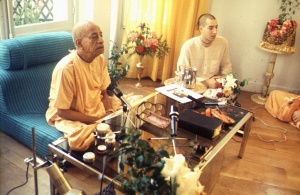SB 1.3.21 (1962)

A.C. Bhaktivedanta Swami Prabhupada
TEXT No. 21
Tatah saptadashe jatah satyabatyam parasharat Chakre vedatroh shakha dristwa punshosalpamedhasah
ENGLISH SYNONYMS
Tatah—thereafter, Saptadashe—in the seventeenth order of incarnations, Jatah—advented, Satyabatyam—in the womb of Satyavati, Parasarat—by Parasaramuni, Chakre—prepared, Vedotarh—besides the Vedas, Shakha—branches, Dristwa—by seeing, Punsa—the people in general, Alpamedasah—less intelligent.
TRANSLATION
Thereafter in the seventeenth order of the incarnation of Godhead Sri Vyasadeva appeared in the womb of Satyabati by Parasara Muni and He divided the one Veda into several branches and sub-branches seeing the people in general as less intelligent.
PURPORT
Originally the Veda is one. But Srila Vyasadeva divided the original Veda into four namely Sam Yaju Rik Atharva and then again they were explained in different branches like the Puranas and the Mahabharat. Vedic language as well as the subject matter is very dificult for ordinary men. It is understood only by the highly intelligent and self realised Brahmins. But the present age of Kali is full of less intelligent men. Even those who are born by a Brahmin father are, in the present age, as good as the Sudras and the women. The twice born men namely the Brahmin, Kshatriyas and the Vaishyas are expected to undergo cultural purificatory process known as Samaskaras but on account of bad influence of the present age the so-called members of the Brahmins and other high order family, are no more highly cultured. They are called the Dhijabandhu or the friends and family members of the twice-born. But these Dwijabandhus are classified amongst the Sudras and the women. Srila Vyasadeva divided the Vedas in various branches and sub-branches on account of these less intelligent class of men like the Dwijabandhus, sudras and the women.